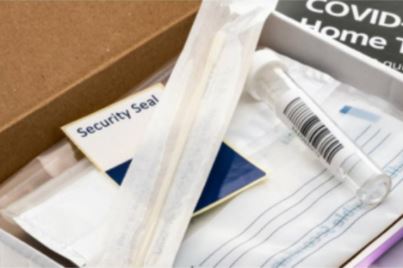
Every home in the U.S. is now eligible to order 4 free at-home COVID-19 tests courtesy of the U.S. Government. The tests are completely free. Orders will usually ship in 7-12 days.
Order your tests now so you have them when you need them. Tests will begin shipping in late January via the United States Postal Service.
If you need a COVID-19 test now, please see other testing resources for free testing locations in your area.
When to Consider Self-Testing
Self-tests may be used if you have COVID-19 symptoms or have been exposed or potentially exposed to an individual with COVID-19.
Even if you don’t have symptoms and have not been exposed to an individual with COVID-19, using a self-test before gathering indoors with others can give you information about the risk of spreading the virus that causes COVID-19. This is especially important before gathering with unvaccinated children, older individuals, those who are immunocompromised, or individuals at risk of severe disease.
A positive test result indicates that you likely have a current infection, and you should isolate and inform close contacts.
A negative test result indicates that you may not be infected and may be at low risk of spreading disease to others, though it does not rule out an infection. Repeating the test will increase the confidence that you are not infected. Performing serial tests, meaning two or more tests over several days with at least 24 hours between tests—with one test as close as possible to the event you will attend—improves the reliability of testing and reduces your risk of transmitting disease to others even further. Some self-tests require this type of repeat testing in the manufacturer’s instructions.
- COVID-19 self-tests (also referred to as home tests or over-the-counter (OTC) tests) are one of many risk-reduction measures, along with vaccination, masking, and physical distancing, that protect you and others by reducing the chances of spreading SARS-CoV-2, the virus that causes COVID-19.
- Self-tests can be taken at home or anywhere, are easy to use, and produce rapid results.
- You can use self-tests, regardless of vaccination status, or whether or not you have symptoms.
- Follow all of the manufacturer’s instructions for performing the test.
- If you test positive, you should isolate and inform your healthcare provider, as well as any close contacts.
- Consider using a self-test before joining indoor gatherings with others who are not in your household.
- A positive self-test result means that the test detected the virus, and you are very likely to have an infection and should stay home or isolate for 10 days, wear a mask if you could have contact with others, and avoid indoor gatherings to reduce the risk of spreading disease to someone else.
- A negative self-test result means that the test did not detect the virus and you may not have an infection, but it does not rule out infection. Repeating the test within a few days, with at least 24 hours between tests, will increase the confidence that you are not infected.
Tips
- Store all test components according to the manufacturer’s instructions until ready for use.
- Check the expiration date. Do not use expired tests or test components that are damaged or appear discolored based on the manufacturer’s instructions.
- Clean the countertop, table, or other surfaces where you will do the test.
- Do not open test devices or other test components until you are ready to start the testing process.
- Have a timer ready because you may need to time several of the test steps.
- Read test results only within the amount of time specified in the manufacturer’s instructions. A result read before or after the specified timeframe may be incorrect.
- Don’t reuse test devices or other components.
After you have the results, discard the specimen collection swab or tube and test in the trash, clean all surfaces that the specimen may have touched, and wash your hands.
